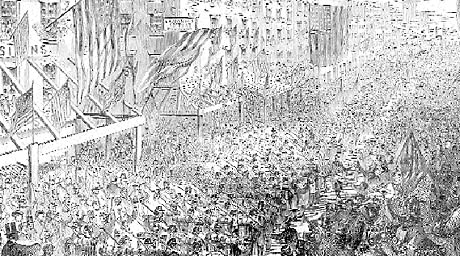The
Sons of Old Monroe
(continued)

When
Johnny went marching off: Such scenes were common throughout the North as large
crowds came out to send off the new recruits. Engraving from Frank Leslie's Illustrated
History of the Civil War, 1896. Only 26 years old, O'Rorke
seemed destined for a great career in the military.
Aug.
26 the new regiment's first company went into camp. Capt. Milo Starks had set
up a recruiting office in the village of Brockport and filled his ranks with “farmers
and sons of farmers” from the surrounding towns of Clarkson and Sweden. The
company was originally intended to be a part of the 108th infantry, but that regiment
had filled its ranks. Starks and his men instead became the first company of the
new regiment.
As the companies rounded out, they were brought into camp.
A company composed almost entirely of Germans (men with names like Helligensetzer,
Schmitt, Stetzenmeyer, and Humreghausen) appeared on the bluffs on the 29th. The
organization made a grand entrance, having been escorted to the camp by the German
Grenadiers militia unit and Newman's regimental band. By Sept. 3, all 10
companies were in camp. There, each soldier was equipped with a uniform, shoes,
blanket, knapsack, canteen and haversack, which was a small tarred canvas bag
in which the soldier would carry his rations. Two days later Lt. Ira Clark, a
Rochester lawyer and ex-school teacher who was serving as the regiment's adjutant,
returned from a trip to Albany with the news that the regiment had officially
been numbered as the 140th. There was no way to predict how the new soldiers
would fight, but it appeared that they would at least be a handy collection of
men. Over 300 were farmers and another 100 considered themselves “laborers,”
but the majority of the other 600 were skilled craftsmen. Shoemakers, blacksmiths
and mechanics were well-represented, as well as coopers, carpenters, joiners,
moulders and painters. The dentist, gunsmith, barber, tailor and tinsmith were
sure to come in handy in camp; of less benefit, but worth boasting about, were
the boatbuilders, two boat captains (among 43 boatmen), carriage builders and
the piano maker. There was a great deal of activity as the regiment neared
the final stages of its formation. The men had many visitors to camp, both official
and unofficial. Sunday was the most popular day to visit and Sept. 7 proved no
exception. The local newspapers estimated that close to 15,000 people visited
the camp that day. On the 8th came news that Rochesterian Patrick Henry
O'Rorke was selected as colonel of the 140th. Looking at his background it is
a wonder that he was not the first choice of the Military Committee. Only 26 years
old, he seemed destined for a great military career. The youngest of eight
children, Patrick was born in Ireland March 28, 1836. The family moved to America
when he was but a year old and settled in Rochester in 1842. The O'Rorkes established
a home in a section of the city populated by fellow Irishmen and known as “Dublin.”
O'Rorke received his primary education in the city's public schools. His
academic talents were acknowledged in 1855 when he was offered a scholarship to
the University of Rochester. His mother had some misgivings about Baptist control
of the college and in accordance with her wishes, O'Rorke declined the scholarship.
He instead entered an apprenticeship to learn the trade of stone cutting. O'Rorke's
quickly-perfected skill in masonry may have become his career had it not been
for a disturbing pattern in the local appointees to the U.S. Military Academy.
The Rochester lads had not had a good time of it scholastically and it became
a point of civic pride to send a top-notch prospect. U.S. Rep. John Williams asked
the commissioner of schools to recommend such a young man and, without hesitation,
the commissioner gave him the name of O'Rorke. O'Rorke accepted the appointment
and entered the U.S. Military Academy July 1, 1857. O'Rorke did not disappoint
his supporters. He graduated in the second class of 1861 at the top of his class.
As a staff officer, he saw action in July 1861 at the first battle of Bull Run.
After the battle he was assigned duty as assistant engineer of the defenses
which encircled Washington. In October he was transferred to Federal forces operating
along the coast of South Carolina. O'Rorke remained there until summer, when he
was granted a furlough to take care of some personal business at home. July 9,
he married his childhood sweetheart Clara Wadsworth Bishop in St. Bridget's Church.
2
Back |
Next
According
to WebCounter you are the  person to answer the Clarion Call
person to answer the Clarion Call
©2008 Clarion Publications, Inc. All
Rights Reserved.
This site designed by Clarion Communications. | 
